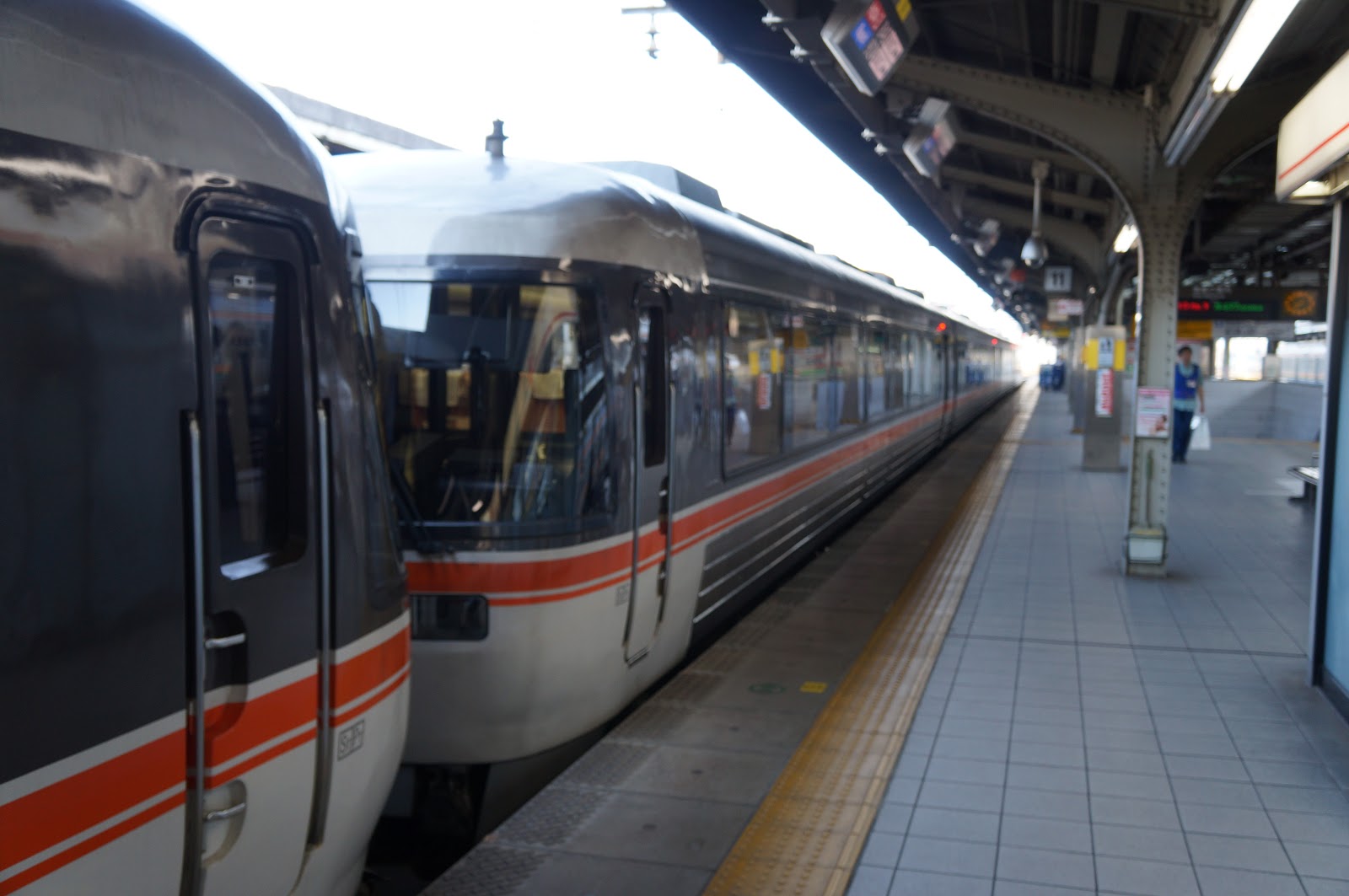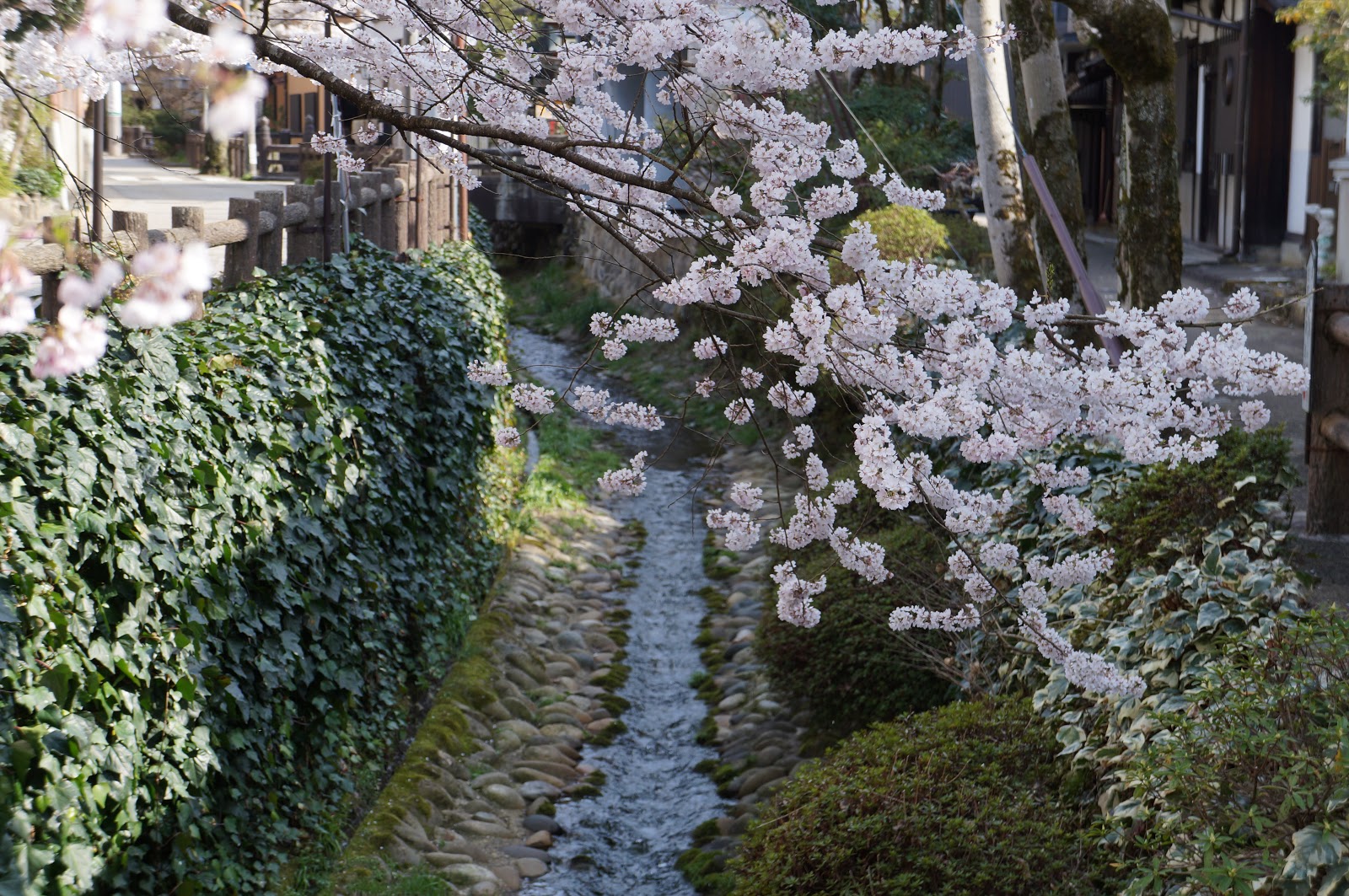I am never happy to stop before the end of the line. It irritates me to know that there is still somewhere unexplored lying ahead. So when I only got as far as Gujo Hachiman on the Nagaragawa Railway last year I knew I needed to return for more. Especially as this private third sector railway is, by its very nature, always at threat of closure due to low patronage.
But did Gujo Hachiman deserve another visit? Sure it's a nice enough town, but had we missed out on enough last time to return?
Mum's trip provided the excuse. I originally planned the Oito line, which wI'll be partly closed when the Shinkansen line is extended to Kanazawa. However, when I thought of special places in Japan that deserved to be shared Gujo Hachiman was at the top of the list.
Before we could go anywhere Mum needed her coffee. There was a Tully's Coffee opposite the hotel entrance, so I parked her there while I booked our seat reservations.
Mum got her fast train ride on a Shinkansen. The hour long journey to Nagoya isn't the most scenic, but it's all new to Mum. In the distance we could see snow atop the distant mountains.
At Nagoya we changed to the comfortable Wide View Hida to Minoota. Immediately we hear the sounds of Singaporean voices.
The train first reverses to Gifu before changing direction. This line is busy with tourists enroute to the historic city of Takayama. It is one of the more scenic lines, running alongside the Kiso, then the Hida river valleys. We only travelled the former stretch, stepping off at Minoota, where we had a half hour wait.
The single car train of the Nagaragawa Railway was surprisingly full by the time we boarded.
Initially we both sat down in the high and straight backed green seats. Having photographed the route last year from the front of the train I thought I would sit this one out, but the scenery drew me up to the end of the car.
There is something hypnotically enticing about parallel lines visually converging in the distance as you rattle along through corridors of pink and white cherry blossoms, past farms and small towns, alongside the clear blue Nagara river that gives the line its name, it's surface broken by jagged grey stone.
The quality of train had steadily declined as the day progressed, from the superfast and luxurious Shinkansen, to the slower but still comfortable Wide View Hida and now this tiny, bumpy rail car. But of the three this was my favourite, the one that evoked the greatest sense of adventure. Each time we stopped and the door opened a scent of diesel and oil, reminiscent of heritage trains, entered the cabin.
I had only bought tickets to Gujo Hachiman, but when we arrived I grabbed another pair from the dispenser at the back door, and we continued onwards to Hokuno at the end of the line. If I didn't do it now I might never have the opportunity again.
You might think me crazy to go on a pointless journey to nowhere, as that is what Hokuno is. But I was not alone in this insanity, not in Japan. At least one ,other, an old Japanese lady was doing the same.
Tiny Hokuno station, a couple of points and an old turntable one used to reverse the direction of steam locomotives, trades on the obsession of the Japanese with their trains. Adjacent to the waiting room is a small cafe serving noodles and selling a small selection of Nagaragawa Railway paraphernalia, including crackers with pictures of the railway baked on. With only a twenty minute stop before the return trip I wasn't certain if there was enough time for a quick lunch for our lagged stomachs, but I suspect we would have made it.
This line was once planned to connect with the still JR Etsumi-Nan line running from the west coast, but it was never completed. Now there are not even direct bus services between the two terminii.
We all piled on back on board the train for its return, railway geeks and my Mum. It's a nice half hour journey. Behind us a few mountains were still covered in snow, the ski fields of the Hakusan National Park.
The station master's office at Gujo Hachiman has a small collection of historic items, railway caps, old telephones, ticket punches and photos of the line. It is only a short walk to the Ryokan Azumaya, where we stayed last time.
Check in is not until 3.30 pm, but they kept our bags so we could explore unencumbered.
The first port of call was to be lunch, but we were distracted along the way. First by the nearby Iwasaki Sample Factory. Most of Japan's amazing food replicas that are displayed at the front of restaurants across the country are made in Gujo Hachiman. At the sample factory you get a chance to assemble your own wax versions of tempura, something we'd missed out on last time.
You start with a ready made plastic prawn and a couple of vegetables. Then yellow wax is dripped into warm water forming a tempura batter splatter that is wrapped around the object, which is the cooled in cold water.
Next sheets of white and green wax are poured out and wrapped together and sliced to make lettuce halves. Surprisingly realistic! I got the items to take home - I hope they won't melt along the way.
The commercial items are made of plastic and there are a large selection of them available for purchase at the adjacent shop.
The sight of this food only served to enhance our hunger, but as with last time it was difficult to find somewhere to actually eat. Photographs of a private garden and tea distracted and we sat down on the tatami to indulge. While Mum had a proper matcha (tea made from powder) with a sweet and wagashi at the side I decided to try something a little different with a frothy green sweet milk tea, quite nice. The commercially packaged biscuit at the side detracted from the effect.
I found a bottle of grapefruit Gokuri in a vending machine. Surely most auspicious!
We finally had lunch, me with gyudon (beef and rice) and Mum with chicken and soba noodles at a cafe overlooking the magnificent river.
The buildings of Gujo Hachiman cling to the side of the river and it is this site that is one of the things that make this place special, but just one.
Next we stopped by the tourist office where a young lady helped us reserve tickets on the next day's bus to Takayama. Mihara-san (?) had been to Australia on a study trip in 2000 and had fond memories of the place.
Time was running out for the day, so we had to hurry to the remaining sights. First was Jion-Zenji temple. I wanted Mum to see the (no photos allowed!) Tetsuso-en gardens. Though small, when viewed from the tatami matted room, they formed a postcard image of serenity, with the peaceful sound of the lightning shaped waterfall relaxing the listener. It's difficult to believe that the scene is covering a short road tunnel!
We hurried back to the town centre for a taxi ride up to the reconstructed castle overlooking the town. I don't think Mum could have hiked up to it. Indeed she couldn't even make it up the steep ladder stairs to the top level of the main turret. Unlike most reconstructions this is of wood, not concrete, though the interior is not of the original.
The views from the top are magnificent. It's a pretty walk back down the hill as well, under the tree canopy, but Mum struggled on the rough steps.
We then took a stroll through the temple district and old streets, accompanied by the sound of rushing water streaming through the drains from the famous springs of the town.
After stopping for more views of the river we eventually made it to the tourist office recommended restaurant, which had beautiful views of the river as darkness fell. Mum ordered a pork katsudon set, me hoba miso with Hida beef. I had been looking forward to hoba miso, beef and vegetables in miso cooked on a magnolia leaf over a flame, for years. But it was a mistake to order it for myself. I had one of my migraines, brought on by too little sleep, and the strong flavour of miso was overwhelming. Fortunately, my Mum ate it as I could not bare to waste such a wonderful meal, especially the Hida beef, one of the wonders of the food world.
The cold air outside and a couple of paracetamol tablets made me feel a lot better, but I was glad to return to the ryokan. After saying goodnight to Mum I headed out to grab a couple of snacks for my now hungry but still fragile stomach from the nearby convenience store, echoing our last trip again.
What made me feel a whole lot better was the hot Japanese bath and the warm futon awaiting me on the tatami in my room. Finally, rest.






















































Comments
When we travel in a week, we won't make it to Hokuno or even as far as Gujo Hachiman, which is a shame, but we want to stop and look at the swords and cutlery in Seki.
I'm sorry to as a weird question, but from your post it sounds as if you buy the ticket for Nagaragawa Railway in the rail car. Is that right?
Complicated I know, but so long as you have the ticket (and I forgot once!) the driver will help you out though don't expect any English.
A similar system is often used for buses and trams in Japan, so you should be able to find some instructions with pictures somewhere On the Japan Guide website or similar (sorry I'm posting this from a mobile -I'll see what I can find later).
Good luck and have fun!
The plastic food still amazes me!